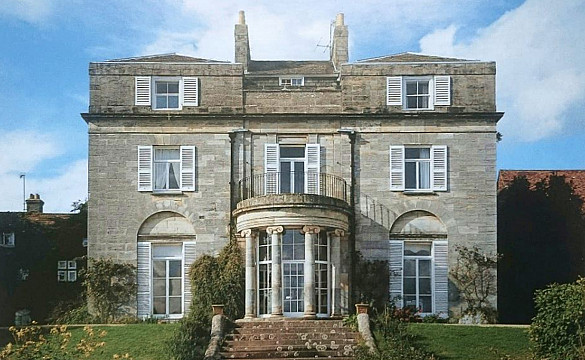Ashdown House
Forest Row, East Sussex
Completed in 1794, for John Trayton Fuller (1743-1811) and his second wife, Hon. Anne Elliot (1754-1835). It was designed by Benjamin Latrobe (1764-1820) who two years later emigrated to America where he is best known as the architect of the United States Capitol and for adding the portico on to the south front of The White House. Ashdown was Latrobe's second private commission in England. It bears a distinct similarity to the Van Ness House that he called "the best house I ever designed"....

This house is best associated with...
The Fullers were long settled in East Sussex where they became wealthy through the iron industry in the Weald. But, through an opportune marriage in 1709 to the Rose family, their wealth was greatly increased when they came into the possession of several sugar plantations in Jamaica, though only one member of the family ever lived there. The Fullers were among those families that lobbied hard to maintain the slave trade.
In 1793, John Trayton Fuller acquired the estate known as Lavertye, originally a small manor subsidiary to Brambletye. Latrobe built this square structure adjoining the existing late 16th century gabled manor house, which thereafter was used for kitchens, servants quarters, and stables. After Mrs Fuller died in 1835, it passed to her eldest son, Augustus Elliot Fuller (1777-1857), who kept a small pack of harriers here. In due course, it passed to his eldest son, Owen Fuller-Meyrick (1804-1876), but ten years after his death Ashdown House became a famous prep school, sold by the Cothill Trust for development in 2021.
In 1793, John Trayton Fuller acquired the estate known as Lavertye, originally a small manor subsidiary to Brambletye. Latrobe built this square structure adjoining the existing late 16th century gabled manor house, which thereafter was used for kitchens, servants quarters, and stables. After Mrs Fuller died in 1835, it passed to her eldest son, Augustus Elliot Fuller (1777-1857), who kept a small pack of harriers here. In due course, it passed to his eldest son, Owen Fuller-Meyrick (1804-1876), but ten years after his death Ashdown House became a famous prep school, sold by the Cothill Trust for development in 2021.
You May Also Like...
Categories
Styles
Share
Connections
Be the first to connect to this house. Connect to record your link to this house. or just to show you love it! Connect to Ashdown House →








